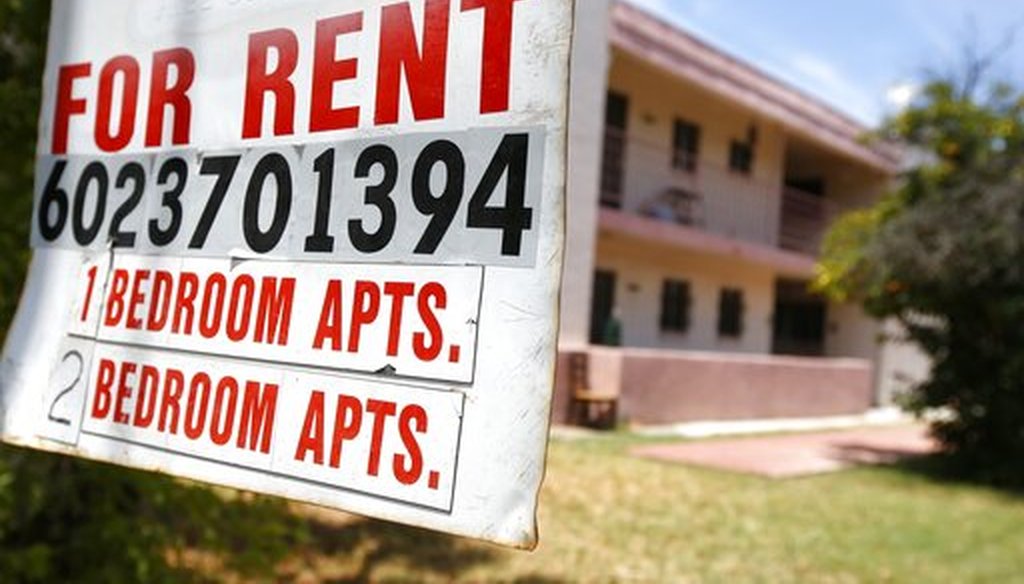Stand up for the facts!
Our only agenda is to publish the truth so you can be an informed participant in democracy.
We need your help.
I would like to contribute

A rental sign in front of an apartment complex in Phoenix on July 14, 2020. (AP)
If Your Time is short
• An eviction moratorium for properties linked to federal housing financing was included in the CARES Act, a major coronavirus relief bill. The moratorium expired in late July.
• Trump’s executive order doesn’t extend the moratorium. Instead, it takes a softer approach by telling executive branch officials to think about possible solutions to evictions during the coronavirus pandemic and its related economic downturn.
President Donald Trump signed an executive order on Aug. 8 that addressed eviction policy. But it didn’t extend an expired federal eviction moratorium, and even if it had extended the moratorium, not every renter would be covered.
Evictions have become an urgent matter during the coronavirus pandemic, because the pandemic has prompted a severe economic downturn and caused many renters to lose their jobs.
An eviction moratorium that had been included in the coronavirus relief bill known as the CARES Act expired on July 24 and has not yet been extended. Between 30 million and 40 million people could be at risk of eviction over the next few months without an extended moratorium, the National Low-Income Housing Coalition estimated.
Here’s a look at the eviction moratorium that expired, as well as what Trump’s executive order does and doesn’t do.
What the CARES Act did on evictions
The CARES Act, which was passed with almost universal bipartisan support and was signed by Trump on March 27, provided a 120-day eviction moratorium for renters in specific categories. Those categories included renters who received federal housing assistance (such as by living in public housing or by receiving federal financial assistance or tax credits), as well as renters who lived in properties in which the landlord’s mortgage is backed by the federal government, including the mortgage-bundling entities Fannie Mae and Freddie Mac.
However, the ban in the CARES Act expired on July 24, and to date, it has not been extended.
A different federal eviction moratorium is still in place, but it is set to end on Aug. 31. That one, imposed by the Federal Housing Finance Agency, pauses foreclosures and evictions for single-family homes that have mortgages backed by Fannie Mae and Freddie Mac.
Separately, renters may have protections under state or local policies.
What Trump’s executive order did
Trump’s executive order falls well short of extending the moratorium from the CARES Act. Instead, it tells executive branch officials to think about possible solutions, rather than formally imposing a moratorium.
Here are the key provisions of Trump’s order:
• It tells the Health and Human Services secretary and the director of the Centers for Disease Control and Prevention to "consider whether any measures temporarily halting residential evictions of any tenants for failure to pay rent are reasonably necessary."
• It tells the Treasury secretary and Housing and Urban Development secretary to identify federal funds that can be applied to "temporary financial assistance to renters and homeowners."
• It tells the director of the Federal Housing Finance Agency to identify "resources that may be used to prevent evictions and foreclosures for renters and homeowners" caused by the pandemic. (As an independent agency, it’s unclear whether the president can order the agency to do anything.)
Unlike the CARES Act eviction ban, "the executive order does not ‘put a hold’ on evictions at all," said Andrew Scherer, the policy director of New York Law School’s Impact Center for Public Interest Law.
Our Sources
Facebook post, Aug. 8, 2020
Donald Trump, executive order, Aug. 8, 2020
National Low-Income Housing Coalition, "The COVID-19 Eviction Crisis: An Estimated 30-40 Milion People in America Are at Risk," Aug. 7, 2020
Center on Budget and Policy Priorities, "Extend CARES Act Eviction Moratorium, Combine With Rental Assistance to Promote Housing Stability," July 27, 2020
Federal Housing Finance Agency, "FHFA Extends Foreclosure and Eviction Moratorium," June 17, 2020
Wall Street Journal, "What’s in Trump’s Executive Actions on Coronavirus Aid—and What’s Not," Aug. 10, 2020
Washington Post, "Here’s what is actually in Trump’s four executive orders," Aug. 9, 2020
Email interview with Andrew Scherer, policy director of New York Law School’s Impact Center for Public Interest Law, Aug. 10, 2020




































